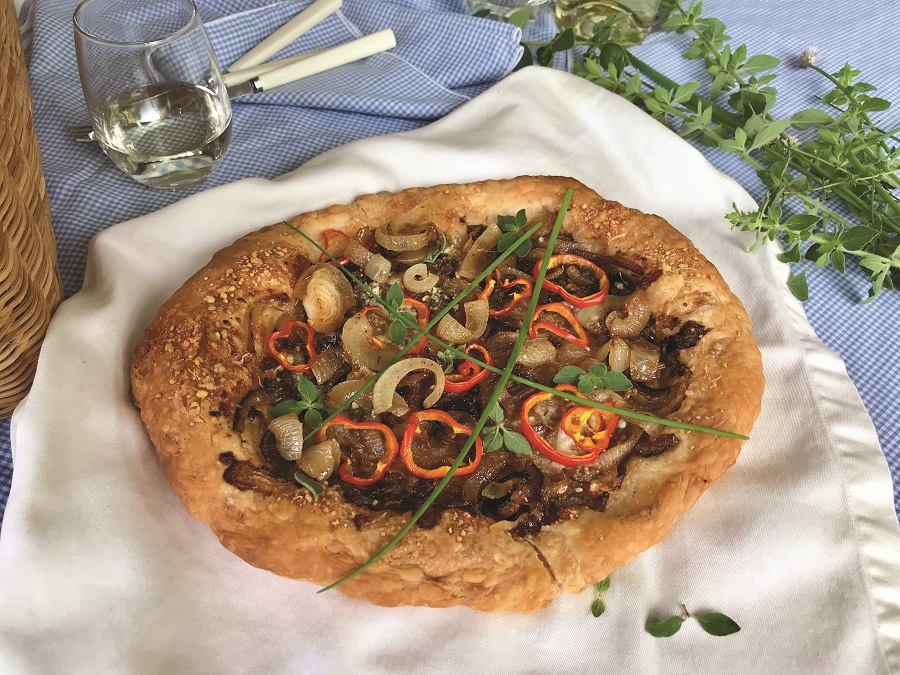An oddly familiar voice on the phone said, “I’ve received your letter and would very much like to contribute to your cookbook.” Momentarily stunned, I caught my breath as she added: “This is Julia Child.”
Deciding to create a cookbook for the museum where I was working in Washington, D.C., whose directors did not see the point in having a cookbook, put me on shaky ground. But I persisted in imagining a tribute by master chefs to the museum’s works celebrating food, its rituals and meanings.
With Julia signed on, other chefs quickly joined in, and I sent each a variety of images I hoped would inspire a menu. Again, Julia was the first to respond. She would create a picnic menu for a Toulouse-Lautrec lithograph of a woman and man riding into the countryside with, she imagined, a picnic basket tucked in the back of their carriage. It was a touching choice, as she had recently lost her husband, the diplomat Paul Child.

Though Julia never said so, I always thought it was a picnic she wished to prepare for him. It began with champagne and a caramelized onion tart, proceeded to roasted pheasant, served cold with Parma ham and figs, a rich Époisses cheese, and finally chocolate lace cookies and large, sweet green grapes, all accompanied by appropriate wines.
I adore the menu to this day and still dream of making it, though the fact is I never got beyond the onion tart — but what a tart. Quickly turned out, it makes a perfectly delicious picnic food or hors d’oeuvre to serve with drinks for a casual summer gathering.
I learned some unforgettable lessons from Julia. Her expertise in getting things done, and done right, created good will all around. Where others might equivocate about their recipes, the editing, or questions from the recipe testers, she only thanked everyone for their good work.
On the elaborate process of making puff pastry she was adamant: it’s not necessary! Store-bought frozen puff pastry, I can still hear her saying, “is perfectly acceptable.”

Then there is this easy tart itself, a pissaladière with flavors of Nice, France. It works every time. I always think of her when it comes out of the oven, fragrant with the magic of the pastry, caramelized onions, and herbs.
Julia artfully arranged anchovies on her picnic tart — they’re traditional. My own renditions depend on what is at hand or in season: sweet red peppers or roasted cherry tomatoes, capers, and especially small black olives are possibilities in keeping with the tart’s very old Provençal origins. The anchovies provide a warmth and salty undertone to the flavors. But they’re not for everyone. Sometimes I’ll make two tarts, one with the filets or anchovy paste, and one without.
In our kitchen we forego herbes de Provence for our own herbes de Cape Cod — fresh now and dried later. Thyme, oregano, chives, lavender, dill, sage, and others all flourish on the Cape, so why not make ample use of them? We dry them as gifts for faraway family and friends.
You can roll out the pastry disks ahead of time and refrigerate them. The onions, too, can be caramelized up to a day before you plan to serve the tart. Then it’s just a matter of assembling the pastry and baking while the guests are on their way.
Caramelized Onion Tart
Makes 4 servings
Note: the frozen puff pastry is enough for 2 tarts; I roll and cut two disks, freezing one for later, so the topping quantities listed here are for one tart. If you’re making two tarts, double the topping ingredients.
14 oz. frozen puff pastry, thawed (enough for two tarts)
4 Tbsp. grated Parmesan or other hard cheese
2 Tbsp. olive oil
¾ lb. onions, thinly sliced
½ tsp. dried thyme or oregano
Salt and pepper
4 anchovy filets, drained (optional), red bell pepper and fresh herbs to garnish
- Preheat the oven to 450° F.
- On a well-floured surface, roll out the thawed puff pastry until it is very thin, about 1/8 inch thick, and cut out a 10-to-12-inch disk, using a dinner plate as a guide. Roll the pastry around your rolling pin and unroll it onto a pizza pan or baking sheet. Prick the dough with a fork and sprinkle on 2 tablespoons of cheese. (Cut out a second disk from the remaining pastry, wrap and seal tightly, and freeze for later use.)
- Sauté the onions in olive oil over medium heat for about 5 minutes, until they are soft, then continue cooking over higher heat for a few more minutes until they brown. Stir in the dried herbs and salt and pepper to taste.
- Let the onions cool before spreading them over the tart, along with the remaining cheese. If using anchovies, olives, or other garnishes, place them on top of the cheese. Bake the tart for 25 to 35 minutes in the lower part of the oven until it is lightly browned and the bottom of the pastry is crisp.
- Serve the tart warm or cool it on a rack to serve at room temperature, cut into wedges and garnished with more fresh herbs.
Editor’s note: The menus became The Artist’s Table: A Cookbook by Master Chefs Inspired by Paintings in the National Gallery of Art, ed. Carol Eron (Rizzoli) (HarperCollins, 1995).



